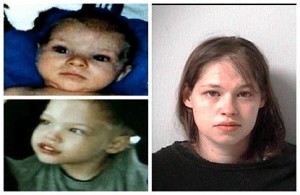A woman calmly called 911 to report her baby boy wasn’t breathing on Tuesday and then hours later confessed to killing him and her two other young sons over the past months because her husband ignored their daughter, authorities said.Brittany Pilkington was charged with three counts of murder and was jailed, said police in Bellefontaine, about 60 miles northwest of Columbus.
Pilkington is accused in Tuesday’s death of three-month-old Noah and in the deaths of four-year-old Gavin, who died in April, and three-month-old Niall, who died in July 2014.
No working telephone number for the family’s home could be found, and no attorney information was available for the mother.Police said officers went to the family’s apartment on Tuesday morning after an emergency call from the mother saying Noah wasn’t breathing.
They said she calmly answered a dispatcher’s questions while the baby’s sleep apnea alarm beeped in the background. Noah was pronounced dead at a hospital.
Logan County prosecutor William Goslee told The Columbus Dispatch he interviewed Brittany Pilkington and she confessed to killing each of her sons by placing a blanket over their heads and suffocating them.
‘In her mind,’ Goslee said, ‘she was protecting her daughter from being not as loved as the boys were by their father’.The daughter, three-year-old Hailey, was taken into custody by a county child welfare agency.
Authorities already were investigating what happened to Niall and Gavin, whose causes of death haven’t been determined. In each of those cases, their father, Joseph Pilkington, found them unresponsive when he got home from work.
‘Our son’s not breathing,’ Brittany Pilkington said meekly to a dispatcher when she called police on April 6 as her husband frantically gave Gavin chest compressions. ‘He’s turning white.’
Joseph and Brittany Pilkington were cooperative on Tuesday, police said. She eventually told detectives that she killed all three boys, police said.
‘The tragic deaths of Niall, Gavin and Noah leave a pit in our stomachs today,’ police chief Brandon K. Standley said in a statement.’Our condolences go out to the remaining family members who have supported this family through a very difficult 13 months.’
Brittany Pilkington’s uncle Joe Skaggs said Hailey and Noah had been with Logan County Children’s Services after Gavin’s death and were returned to their parents this month.
‘Why would you give them back after a little boy just died and when you’re in the middle of an investigation?’ Skaggs, standing in front of his niece’s apartment, told the Dispatch.
A voicemail system at the agency wouldn’t accept messages after hours Tuesday. But Goslee, the prosecutor, said Hailey and Noah were given back to their parents after a coroner determined Gavin’s and Niall’s deaths weren’t suspicious.
The Pilkingtons’ neighbor James Breaston was home, across the hall from the family, when Gavin died in April. He remembered consoling a distraught Joseph Pilkington but finding Brittany Pilkington unperturbed.
‘He was crying, the tears were rolling, and she was just cold,’ Breaston told the Dispatch. ‘She just stared like nothing happened.’He said that when saw police arrive on Tuesday morning he thought, ‘Oh, there’s another baby dead.’
She also reported having thoughts of depression, may have been prevented from seeking help and has made allegations of physical abuse as a child, prosecutors said.
It’s a description that mirrors some of the trends identified in decades of research on filicide — when a parent kills their child.
As the community struggles to make sense of the deaths of three young children, a deeper look at the family’s history and the young mother’s mental state may shed some light on how these events unfolded.
“She’s not a monster,” Pilkington’s mother Lori Cummins said.
A 2007 review of psychiatric research by Case Western Reserve professor Dr. Phillip Resnick showed that filicidal mothers show frequent depression, psychosis, prior mental health treatment and suicidal thoughts.
“The mothers were often poor, socially isolated, full-time caregivers, who were victims of domestic violence or had other relationship problems,” the article in World Psychiatric said.
But every case is unique, Resnick said, and no set of factors automatically means someone will harm their child. He’s studied mothers who kill their children for the past 50 years.
“It’s not like there is a profile,” he said.
Numerous motives
Police have accused Pilkington of killing 3-month-old Noah Pilkington on Tuesday; 4-year-old Gavin Pilkington in April and 3-month-old Niall Pilkington in July 2014. Noah had been returned from foster care six days before his death.
Her bond has been set at $1 million.
She confessed to smothering all three boys by holding a blanket over their faces, prosecutors said, because she was jealous of the attention her husband gave their sons instead of their daughter. She has since claimed she is innocent in a jailhouse conversation with her mother.
“I can’t see her doing this,” Cummins said.
Resnick has interviewed dozens of women who have killed their children and said while trends have emerged from the data, there is truly no profile the perpetrators follow.
A Brown University study published last year in Forensic Science International found that the number of filicides in the U.S. has remained steady over the past three decades at about 500 per year.
About one-third of the children killed consistently are infants younger than 1 year old. Close to three-quarters of the more than 15,000 cases studies involved children younger than 6 years old.
That study found that men are more likely than women to kill their children, accounting for about 54 percent of deaths.
Reasons that women kill their children appear to fall into a handful of categories, Resnick said.
Some killings are altruistic, when a mother believes death is in the child’s best interest. That’s sometimes the case in murder-suicides.
When Lashanda Armstrong drove her minivan into a freezing New York lake in 2011, she told her children, “If I’m going to die, you’re going to die with me,” according to media reports quoting her 10-year-old son who survived. Three younger children drowned.
Some children die as a result of child abuse or neglect, while others may be killed because they are unwanted. That’s most often seen with teenage mothers, unplanned pregnancies or those who didn’t know they were pregnant.
The rarest motive is spousal revenge, according to Resnick’s research, when a parent kills the child specifically to emotionally harm the other parent.
This motive was suggested in the case of China Arnold in Dayton. She put her 28-day-old daughter in the microwave after a drunken argument with her boyfriend over whether the infant was his biological daughter. Arnold is serving life in prison.
Some cases come down to psychosis, Resnick said, and then there really isn’t any comprehensible motive.
Christina Miracle of Clermont County was found not guilty by reason of insanity after performing a religious ceremony to baptize her 6-year-old son — trying to bring her dead brother back to life — when she suffocated the child in 2004, the Cincinnati Enquirer reported.
Family dynamic
Any number of health issues can come into play and affect a parent’s likelihood of harming their child or themselves, said Sue Fralick, vice president of operations for Mental Health Services for Clark and Madison Counties, including depression, bi-polar disorder and substance abuse.
Family dynamics and personal history could also play a role.
“I like to say, ‘What’s happened to this person?’ instead of, ‘What’s wrong with you?’” Fralick said.
Women are more likely to kill a child when they lack the resources to care for that child, Resnick said. That can be financial or emotional support, such as help from a spouse or family.
Brittany Pilkington was under the control of her husband Joseph Pilkington and had lost contact with much of her family, according to Logan County Prosecutor William Goslee.
“He kind of kept her at home taking care of the children,” Goslee said. “He managed to keep her very isolated and therefore she had no friends.”
Multiple attempts have been made to contact Joseph Pilkington but he couldn’t be reached for comment.
No charges are planned against Joseph Pilkington in relation to his children’s deaths, Goslee said.
Thaddeus Hoffmeister, professor of law at the University of Dayton, agreed a high threshold would need to be met to prove he knew his children’s lives were at risk.
“You could charge him with child endangerment,” he said, but you’d have to prove he knew or should have known the boys would be harmed.
While being interrogated by police, Brittany Pilkington described her 3-year-old daughter as her best friend.
Brittany Pilkington’s mother said her daughter appeared to be sheltered.
“She couldn’t even hardly get out of the house unless it was with him,” Cummins said.
Joseph Pilkington originally came into his wife’s life when she was about 8 years old. He dated her mother, Cummins, for about seven years and lived with the family.
Even after the couple broke off their relationship, Joseph Pilkington continued to live in the home and became involved with Brittany Pilkington when she was 17.
“I didn’t think anything of it,” Cummins said of the initial relationship.
But when her daughter became pregnant, she tried to talk Brittany Pilkington out of getting married because she said she had first-hand experience with what she called his controlling ways.
“I wasn’t too happy because she was still in school,” Cummins said.
Her daughter had ambitions of being a nurse and Cummins believed she’d do better to marry someone who wouldn’t hold her back from that.
“I told her, ‘Nobody’s forcing you to get married to him, and he can’t force you,’” Cummins said.
They did get married — two months after Brittany Pilkington turned 18 and a few months after the birth of their first son. She graduated high school, but stayed at home to raise the children.
Cummins said she and Joseph Pilkington disagree over whether he was ever a father-figure to Brittany Pilkington before they got married.
“He says he was just there to help me out,” Cummins said.
She doesn’t believe he knew anything about the cause of the deaths until last week.
Pilkington told investigators that she was abused by her father, Goslee said. Her father denied that and says he would never lay his hands on her.
“She developed a rather jaded relationship with men generally, fathers specifically, and then add to this the component of this highly controlling husband,” Goslee said. “Now she’s giving birth to little boys and I have my own working theory in the case that she did not like little boys because she was afraid that they would grow up to be abusive like her father, maybe controlling like her husband.”
Getting help
Brittany Pilkington told investigators she wanted help after Niall died because she thought she might be depressed, Goslee said, but her husband may have prevented it.
Her mother says Brittany Pilkington never came to her saying she felt depressed or thought about harming her children.
“She’s quiet. She keeps it inside,” Lori Cummins said. “But I could see it myself.”
Her daughter was a good mother, she said, and her grandchildren were happy and laughing when she saw them.
But the young mother was doing everything at the home herself, Cummins said, and seemed to be overwhelmed with her pregnancies and the stress of raising children. She had four children in five years.
“I told her she don’t need no more because she’s got her hands full,” Cummins said.
Cummins didn’t suspect though that her daughter was capable of killing her children and still believes in her heart that she’s innocent.
Health experts in Clark and Logan counties said they look for a number of signs in mothers that could indicate postpartum depression or other mental health issues, including:
■ Inability to sleep or sleeping more than normal.
■ Change in appetite.
■ Extreme concern about their children or lack of interest in them.
■ Feeling unable to love or bond with children.
■ Anger, anxiety or panic attacks.
■ Fear of harming the baby or being left alone them.
■ Sadness or excessive crying.
■ Recurrent thoughts of death or suicide.
The best thing someone concerned about a loved one can do is to listen and try to find solutions, including alerting mental health professionals.
Some people have trouble bonding with their children or find they’re frustrated and don’t really like parenthood.
“You feel guilty about that feeling,” Fralick said, and then ashamed to share it with anyone. “Being able to say it and not have people judge you and then find a way to solve it,” is the best result, she said.
No one is turned away from community services because of an inability to pay, Fralick said.
“The gateway is open for people to get help,” she said.
 Shali Rose: A woman calmly called 911 to report her baby boy wasn’t breathing on Tuesday and then hours later confessed to killing him and her two other young sons over the past months because her husband ignored their daughter, authorities said.Brittany Pilkington was charged with three counts of murder and was jailed, said police in Bellefontaine, about 60 miles northwest of Columbus.
Shali Rose: A woman calmly called 911 to report her baby boy wasn’t breathing on Tuesday and then hours later confessed to killing him and her two other young sons over the past months because her husband ignored their daughter, authorities said.Brittany Pilkington was charged with three counts of murder and was jailed, said police in Bellefontaine, about 60 miles northwest of Columbus. Pilkington is accused in Tuesday’s death of three-month-old Noah and in the deaths of four-year-old Gavin, who died in April, and three-month-old Niall, who died in July 2014.
Pilkington is accused in Tuesday’s death of three-month-old Noah and in the deaths of four-year-old Gavin, who died in April, and three-month-old Niall, who died in July 2014.
 Experts: Bellefontaine mom’s history mirrors some child killers
Experts: Bellefontaine mom’s history mirrors some child killers







